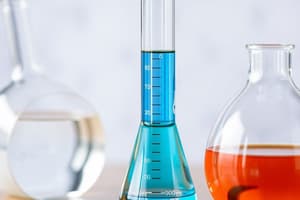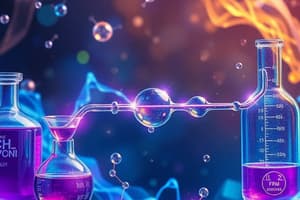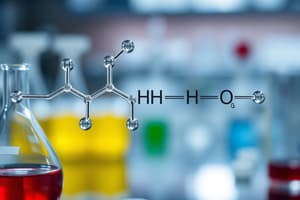Podcast
Questions and Answers
What do the coefficients in a balanced chemical equation represent?
What do the coefficients in a balanced chemical equation represent?
- The mass of each reactant and product
- The energy changes during the reaction
- The number of molecules or formula units of the substances (correct)
- The type of reaction occurring
In the equation 2H2 + O2 → 2H2O, what is the ratio of hydrogen molecules to oxygen molecules?
In the equation 2H2 + O2 → 2H2O, what is the ratio of hydrogen molecules to oxygen molecules?
- 4:1
- 2:2
- 2:1 (correct)
- 1:1
Which of the following represents a correctly balanced equation?
Which of the following represents a correctly balanced equation?
- 4H2 + 2O2 → 4H2O (correct)
- 3H2 + O2 → 2H2O
- H2 + O2 → 2H2O
- 2H2 + O2 → H2O
If the coefficients of the reaction are written as 12.044 × 10² H2 + 6.022 × 10² O2 → 12.044 × 10² H2O, what is the reduced ratio of the coefficients?
If the coefficients of the reaction are written as 12.044 × 10² H2 + 6.022 × 10² O2 → 12.044 × 10² H2O, what is the reduced ratio of the coefficients?
What is the first step in determining molar relationships between substances in a chemical reaction?
What is the first step in determining molar relationships between substances in a chemical reaction?
What is the main purpose of stoichiometry in chemical reactions?
What is the main purpose of stoichiometry in chemical reactions?
In the balanced equation CH₄ + 4 Cl₂ → CCl₄ + 4 HCl, how many moles of HCl are produced from one mole of CH₄?
In the balanced equation CH₄ + 4 Cl₂ → CCl₄ + 4 HCl, how many moles of HCl are produced from one mole of CH₄?
If 100.0 grams of CH₄ are reacted, what is the relationship between the mass of HCl and the mass of CH₄?
If 100.0 grams of CH₄ are reacted, what is the relationship between the mass of HCl and the mass of CH₄?
Which of the following statements about the reaction producing carbon tetrachloride is true?
Which of the following statements about the reaction producing carbon tetrachloride is true?
What does the term 'balanced chemical equation' refer to?
What does the term 'balanced chemical equation' refer to?
How many grams of HCl can be produced from the reaction of 100.0 g of CH₄?
How many grams of HCl can be produced from the reaction of 100.0 g of CH₄?
What does the Greek origin of the term 'stoichiometry' imply?
What does the Greek origin of the term 'stoichiometry' imply?
What is the coefficient of Cl₂ in the balanced equation for the formation of carbon tetrachloride?
What is the coefficient of Cl₂ in the balanced equation for the formation of carbon tetrachloride?
In the reaction 2H2 + O2 → 2H2O, how many moles of water are produced per mole of oxygen used?
In the reaction 2H2 + O2 → 2H2O, how many moles of water are produced per mole of oxygen used?
Which of the following ratios is correct based on the reaction 2H2 + O2 → 2H2O?
Which of the following ratios is correct based on the reaction 2H2 + O2 → 2H2O?
What is the definition of stoichiometry in the context of chemical reactions?
What is the definition of stoichiometry in the context of chemical reactions?
What is the molar relationship between H2 and H2O in the reaction 2H2 + O2 → 2H2O?
What is the molar relationship between H2 and H2O in the reaction 2H2 + O2 → 2H2O?
In the equation 2 mol H2 + 1 mol O2 → 2 mol H2O, how many total moles of reactants are involved?
In the equation 2 mol H2 + 1 mol O2 → 2 mol H2O, how many total moles of reactants are involved?
Which of the following statements about balanced chemical equations is true?
Which of the following statements about balanced chemical equations is true?
Flashcards
Balanced Chemical Equation Coefficients
Balanced Chemical Equation Coefficients
The numbers in front of chemical formulas in a balanced equation; these numbers represent the molar ratio of reactants and products.
Molar Ratio
Molar Ratio
The ratio of the coefficients in a balanced chemical equation, determining the relative amounts of reactants and products in a chemical reaction. These amounts are in moles.
Lowest whole number ratio
Lowest whole number ratio
The simplest, reduced form of the ratio of coefficients in a balanced chemical equation. This is the standard form and most useful.
Chemical Equation
Chemical Equation
Signup and view all the flashcards
Balancing Chemical Equations
Balancing Chemical Equations
Signup and view all the flashcards
Balanced Chemical Equation
Balanced Chemical Equation
Signup and view all the flashcards
Molar Amount
Molar Amount
Signup and view all the flashcards
Stoichiometry
Stoichiometry
Signup and view all the flashcards
Coefficient (in chemical equation)
Coefficient (in chemical equation)
Signup and view all the flashcards
1 mole
1 mole
Signup and view all the flashcards
Mole-to-Mole Ratio
Mole-to-Mole Ratio
Signup and view all the flashcards
Balanced Equation in terms of Moles
Balanced Equation in terms of Moles
Signup and view all the flashcards
Stoichiometry Definition
Stoichiometry Definition
Signup and view all the flashcards
Moles in Reactions
Moles in Reactions
Signup and view all the flashcards
Mass-to-Mass Conversions
Mass-to-Mass Conversions
Signup and view all the flashcards
Carbon Tetrachloride (CCl4)
Carbon Tetrachloride (CCl4)
Signup and view all the flashcards
Methane Reaction
Methane Reaction
Signup and view all the flashcards
HCl production
HCl production
Signup and view all the flashcards
Study Notes
Chapter 8: Quantities in Chemical Reactions
- This chapter explores stoichiometry, the numerical relationships between reactants and products in balanced chemical reactions.
- Chemical reactions often involve large numbers of atoms and molecules, making counting impractical.
- Stoichiometry provides a method for comparing amounts of substances using balanced chemical equations.
- The coefficients in a balanced equation represent the relative number of moles of substances involved.
- 8.1: Climate Change - Too Much Carbon Dioxide: Atmospheric CO2 levels have increased significantly since the Industrial Revolution, primarily due to fossil fuel combustion. Data from ice cores and recent measurements show a clear upward trend.
- 8.2: Making Pancakes - Relationships Between Ingredients: Proportions of ingredients in recipes are analogous to proportions of chemicals in chemical reactions. Ratios between ingredients are key for desired results.
- 8.3: Making Molecules - Mole-to-Mole Conversions:
- Balanced chemical equations can be used to determine the molar relationships between substances in a reaction.
- The coefficients in a balanced equation represent the relative number of moles of each substance.
- 8.4: Making Molecules - Mass-to-Mass Conversions:
- Conversions between the mass of reactants and products can be calculated from a balanced chemical equation and molar masses.
- The molar ratio from the balanced chemical equation is used as a conversion factor.
- Molar mass of a substance is used to convert between mass and moles.
- 8.5: Stoichiometry:
- Stoichiometry is the calculation of the quantities of reactants or products in a chemical reaction using the relationships found in a balanced chemical equation.
- Coefficients in a balanced chemical equation represent the reacting ratios of substances in the reaction.
- The coefficients can be used to determine the mole ratio of all substances involved in the reaction.
- 8.6: Limiting Reactant and Theoretical Yield
- Limiting reactant: The reactant that is completely consumed in a reaction, thus limiting the amount of product that can be formed.
- Excess reactant: The reactant that remains after a reaction has gone to completion.
- Calculations to determine limiting reactant and excess reactant can be done using either the reactant mole ratio method or the "product method".
- 8.7: Limiting Reactant, Theoretical Yield, and Percent Yield from Initial Masses of Reactants
- Theoretical yield: The maximum amount of product that can be formed from the given amounts of reactants, assuming a complete reaction.
- Actual yield: The actual amount of product obtained in a reaction.
- Percent yield: The ratio of the actual yield to the theoretical yield, expressed as a percentage.
- 8.8: Enthalpy Change is a Measure of the Heat Evolved or Absorbed
- Enthalpy: Heat content of a system at constant pressure.
- ΔH: Enthalpy change in a reaction. -Endothermic reactions absorb heat from the surroundings. -Exothermic reactions release heat into the surroundings. -Thermochemical equations include the enthalpy change of the reaction.
Studying That Suits You
Use AI to generate personalized quizzes and flashcards to suit your learning preferences.




